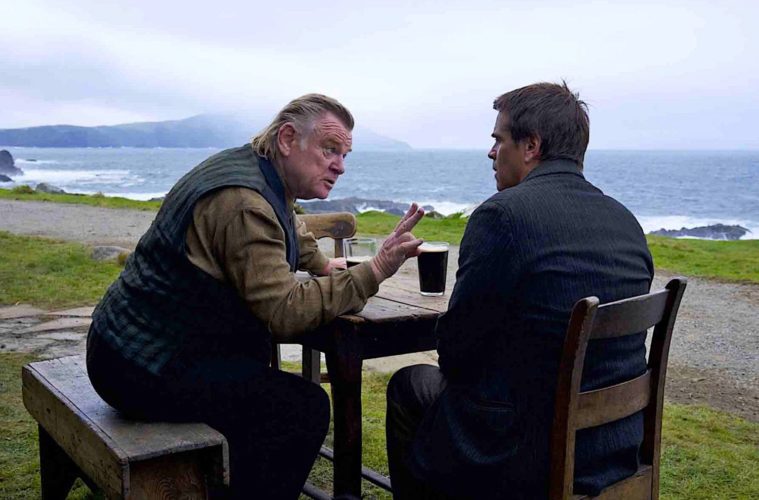 You feel a palpable relief, watching Martin McDonagh’s new film, The Banshees of Inisherin, knowing that the writer/director has gone back to Ireland. His cold-blooded and tone-deaf attempt to nail Middle America, Three Billboards Outside Ebbing, Missouri (2017), was so clotted with unlikelinesses that its raw verbal comedy, McDonagh’s primary superpower, often hung in the air like deflated balloons. He also seemed to know next to nothing about women, motherhood, or Missouri. Often enough, McDonagh’s lust for a transgressive gag loosens his grip on character and reality, and Three Billboards was only partly salvaged by the fact that we tend to believe anything Frances McDormand says and does. The less said about his previous shot at Americana, 2012’s sprawling, nonsensical Seven Psychopaths, the sweeter.
You feel a palpable relief, watching Martin McDonagh’s new film, The Banshees of Inisherin, knowing that the writer/director has gone back to Ireland. His cold-blooded and tone-deaf attempt to nail Middle America, Three Billboards Outside Ebbing, Missouri (2017), was so clotted with unlikelinesses that its raw verbal comedy, McDonagh’s primary superpower, often hung in the air like deflated balloons. He also seemed to know next to nothing about women, motherhood, or Missouri. Often enough, McDonagh’s lust for a transgressive gag loosens his grip on character and reality, and Three Billboards was only partly salvaged by the fact that we tend to believe anything Frances McDormand says and does. The less said about his previous shot at Americana, 2012’s sprawling, nonsensical Seven Psychopaths, the sweeter.
But, ah, Ireland—still a lovely-yet-dreary haven for Americanized romanticization, which homeboy McDonagh visually exploits (the sunsets and mornin’ dew on the emerald hills) while robustly skewering the culture’s self-defeating tendencies in viciously unconventional ways. The new film is an Irish-laconic bolero, building to seizures of violence and crisis from the most shruggably childlike of dramatic triggers: On one of the tinier, and fictional, Aran islands, the somewhat dim Pádraic (Colin Farrell) goes to fetch his pal Colm (Brendan Gleeson) for their daily pint at the pub, but gets no response. When finally confronted, Colm just grumbles, “I just don’t like ya no more,” and an incomprehensible fissure opens up in the tiny community (the film has only 10 speaking roles) and in Pádraic’s understanding of the world. What could have changed? The premise has a Beckettian simplicity, suggesting epochal disruptions out of the most trivial village realities. It’s 1923, and the modern world is coming: On the mainland across the water, the wasteful and perplexing guns of the Irish Civil War can be occasionally heard.
After the sloppy misanthropy of Three Billboards, this new film feels controlled, purposeful, and inventive. Reportedly, Banshees is, or could be, adapted from the unproduced and unpublished third play in McDonagh’s Aran Islands trilogy, after The Cripple of Inishmaan (1997) and The Lieutenant of Inishmore (2006). It certainly has a concise, play-like feel—almost every scene is a one-on-one dialogue joust—and it certainly shares the earlier plays’ obsessions, down to the avenging of wronged pets. But this is what McDonagh’s always been brilliant at: the deadpan Celtic bickering, the edging of bloodshed into the mundane, the hinting at existential chasms beneath a characters’ semi-articulate blather.
The movie takes the downward spiral inch by inch, as Farrell’s “nice” but “dull” islander struggles to understand what in the hell could be happening; his universe is too small to be losing people, and lose them he does. No one else—from Barry Keoghan’s village dope to Pádraic’s sensible sister, played by Kerry Condon—can fathom what’s going on. We don’t quite understand either; Gleeson’s fed-up bear of a man hardly explains himself, though we do glean the depths of his despair once he promises Padraic that he will cut off one of his own fingers every time his ex-friend speaks to him. Which is what happens, in McDonagh’s almost obligatory leap into unlikeliness. The mutilations are also wildly unlikely for the trivial amount of blood and physical trauma—if you take The Banshees of Inisherin to be set in an actual Ireland, and not McDonagh-land.
As it is, the film vibrates with McDonagh’s crisp wit—you wish a confessional scene between Colm and the village priest (David Pearse) would go on for twice its length—and with the sense of pressure on this small island, something bad has to happen. (Minor characters are routinely starved for “news”—gossip, stories, the more calamitous the better.) The movie is also terribly Irish in a potent way, for what isn’t said. Two men in a maddeningly isolated Old World space, suddenly at odds not only with each other but with the limitations of their traditional social rut —is there any escaping? That primal dilemma is the film’s haunting takeaway, not the butcher-block yucks. Dominating the film, Farrell is completely, unglamourously plugged in, as a paradigmatic lost man suddenly knee-deep in collapse and strangeness, and pushed into being a hapless persecutor, not a victim.
Editor’s note: The disclaimer below refers to advertising posts and does not apply to this or any other editorial stories. LA Weekly editorial does not and will not sell content.
Advertising disclosure: We may receive compensation for some of the links in our stories. Thank you for supporting LA Weekly and our advertisers.

